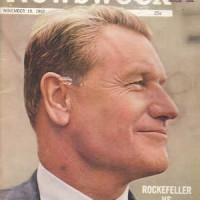 Paul R. Goldman and his furniture manufacturing company, Plycraft, have proved to be elusive quarry. I first became interested in Goldman’s story after I came across his obituary re-posted on a mid-century design blog. Tantalized by a tale of corruption and intrigue, I decided to follow up on his life and company with more in-depth research, and immediately began encountering problems. All of my sources just referred back to the same brief obituary.
Paul R. Goldman and his furniture manufacturing company, Plycraft, have proved to be elusive quarry. I first became interested in Goldman’s story after I came across his obituary re-posted on a mid-century design blog. Tantalized by a tale of corruption and intrigue, I decided to follow up on his life and company with more in-depth research, and immediately began encountering problems. All of my sources just referred back to the same brief obituary.
When I moved laterally to avoid this source bottleneck, I found the vast majority of Internet search results relating to Plycraft were advertisements for pieces of furniture. According to Google, it seems the most important information about Plycraft chairs can be found in expired Ebay auctions. So I began plumbing the bowels of Columbia’s finicky, uncooperative online database system to see what I might find without the clutter of commerce.
In particular, I was searching for a magazine article mentioned in Goldman’s 2003 obituary, a piece in an unnamed November, 1962 issue of Newsweek that calls him “the father of modern plywood technology.” Naturally, I tried Newsweek’s site, but found that the publication has virtually none of their archive available online, ditto for CLIO’s many newspaper aggregators. I even tried a Tumblr account, in which some brave soul had begun digitizing old issues, but there, too, I came up empty.
Resolving myself to the fate of actually having to touch archival materials with my hands, I headed over to Butler’s microfilm room, which purportedly had my mystery issue of Newsweek hidden among its spools of film. In the microfilm room, I faced another series of vexations. Among the dozen computers set up to scan and view the micro-film, only one of them was able to print. The microfilm librarian informed me that this was not a recent development, that Butler’s microfilm room has been running on one operational printer for almost a year. Unfortunately for me, a woman who looked as if she had not moved from her chair in a very long time sat hunched over the one functioning station, so I would have to wait.
After I hovered near her desk for half-hour like some jerk waiting for a table at Starbucks, the woman packed up her papers and left. I threw my coat down, threaded the microfilm through the slots, and got to work. The roll contained every Newsweek from July through December of 1962, and since I didn’t know which issue contained the article in question, I tried the appendix first. No Goldman. No Plycraft. One mention of the opening of Lincoln Center, for which Goldman had manufactured concert chairs. Perhaps I’d finally caught a break. I whirred through the film as fast as my eyes would allow, taking short breathers every time I felt myself turning green, like I’d been trying to read on a moving bus. Of course, the article wasn’t there, only a brief mention of Lincoln Center regarding the opening night of an opera. I decided to go through every November issue.
After hours of fruitless searching, I called my father. A professional researcher, and now a history teacher, my father enjoys lording his superior research skills over my mother and me. I was reluctant to call him, hoping to “do this on my own steam,” etc. – but I saw no other option.
“Have you considered trying another magazine?” he asked. “What if it’s not in Newsweek at all?”I searched an unusual phrase included in that 2003 obituary, this time without Newsweek, and quickly found the article. It had been squirreled away in Time Magazine, and I was thrilled to have finally trapped it. Scrolling furiously, I saw to my chagrin that the article wasn’t really about Goldman at all. He barely receives a mention among a list of other up and coming young businessmen. So back to the drawing board I went.